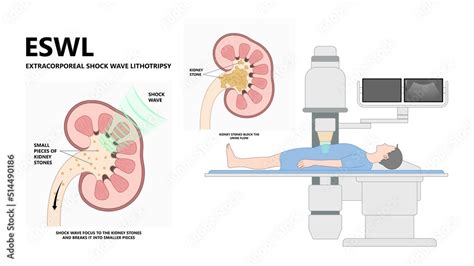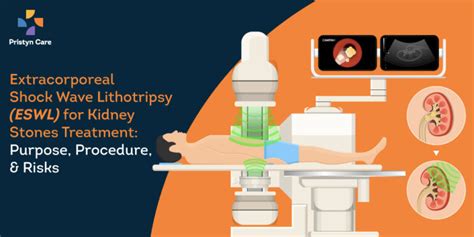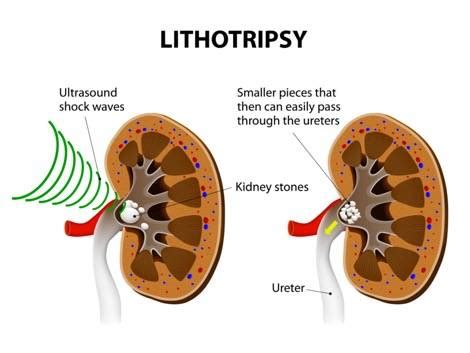Intro
Discover Lithotripsy Treatment, a non-invasive procedure using shockwaves to break kidney stones, ureteral stones, and gallstones, offering relief from painful symptoms through Extracorporeal Shock Wave Lithotripsy (ESWL) therapy.
The world of medical treatments is vast and ever-evolving, with new technologies and methods being developed to address various health issues. One such treatment that has gained significant attention in recent years is lithotripsy, a non-invasive procedure used to treat kidney stones. Kidney stones can be a painful and debilitating condition, affecting millions of people worldwide. The traditional methods of treating kidney stones often involved invasive surgical procedures, which carried risks and required extended recovery periods. However, with the advent of lithotripsy, patients now have a safer and more effective alternative. In this article, we will delve into the world of lithotripsy treatment, exploring its benefits, working mechanisms, and what patients can expect from the procedure.
Lithotripsy is a medical procedure that uses shock waves to break up kidney stones into smaller pieces that can then be easily passed out of the body through urine. This treatment has revolutionized the way kidney stones are managed, offering a non-invasive alternative to surgical interventions. The development of lithotripsy has significantly improved the quality of life for patients suffering from kidney stones, reducing the need for hospitalization and minimizing the risk of complications. As we explore the intricacies of lithotripsy, it becomes clear that this treatment is not only effective but also offers a host of benefits that make it an attractive option for patients.
The importance of understanding lithotripsy treatment cannot be overstated, especially for individuals who are at risk of developing kidney stones. By grasping the fundamentals of this procedure, patients can make informed decisions about their treatment options and take proactive steps towards managing their condition. Moreover, as medical technology continues to advance, it is essential to stay abreast of the latest developments in lithotripsy, including its applications, limitations, and potential future directions. Whether you are a patient, a healthcare professional, or simply someone interested in medical innovation, this article aims to provide a comprehensive overview of lithotripsy treatment, addressing your questions and shedding light on this groundbreaking medical procedure.
Lithotripsy Treatment Overview

Benefits of Lithotripsy
The benefits of lithotripsy treatment are numerous, making it a preferred option for many patients. Some of the key advantages include: * Non-invasive: Lithotripsy does not require surgical incisions, reducing the risk of infection and promoting faster recovery. * Minimally painful: While some discomfort may be experienced during the procedure, lithotripsy is generally considered to be a relatively painless treatment option. * Short recovery time: Patients can usually resume their normal activities within a few days of undergoing lithotripsy. * High success rate: Lithotripsy has a high success rate, with many patients experiencing complete clearance of their kidney stones. * Reduced risk of complications: Compared to surgical interventions, lithotripsy carries a lower risk of complications, making it a safer option for patients.How Lithotripsy Works

Types of Lithotripsy
There are several types of lithotripsy, each with its own unique characteristics and applications. Some of the most common types include: * Extracorporeal shock wave lithotripsy (ESWL): This is the most common type of lithotripsy, which uses shock waves to break down kidney stones. * Intracorporeal lithotripsy: This type of lithotripsy involves the use of a special device that is inserted into the body to break down kidney stones. * Laser lithotripsy: This type of lithotripsy uses a laser to break down kidney stones. * Ultrasonic lithotripsy: This type of lithotripsy uses high-frequency sound waves to break down kidney stones.Lithotripsy Treatment Procedure

Risks and Complications
While lithotripsy is generally considered to be a safe and effective treatment option, there are some potential risks and complications that patients should be aware of. These include: * Bleeding: There is a small risk of bleeding during or after the procedure. * Infection: As with any medical procedure, there is a risk of infection with lithotripsy. * Kidney damage: There is a small risk of kidney damage during the procedure. * Stone fragments: In some cases, the stone may not be completely broken down, and fragments may remain in the body.Lithotripsy Treatment Costs

Insurance Coverage
Most health insurance plans cover lithotripsy treatment, but the extent of coverage can vary. Patients should check with their insurance provider to determine the specific coverage and any out-of-pocket costs they may be responsible for.Lithotripsy Treatment Success Rate

Long-Term Results
The long-term results of lithotripsy treatment are generally excellent, with most patients experiencing significant improvement in their symptoms and quality of life. However, it is essential for patients to follow their healthcare provider's instructions and attend follow-up appointments to ensure that the treatment is successful and to prevent any potential complications.What is lithotripsy treatment?
+Lithotripsy treatment is a non-invasive medical procedure that uses shock waves to break up kidney stones into smaller pieces that can be easily passed out of the body through urine.
How long does lithotripsy treatment take?
+The length of lithotripsy treatment can vary depending on the size and location of the kidney stone, but it typically takes around 30 minutes to an hour.
Is lithotripsy treatment painful?
+While some discomfort may be experienced during the procedure, lithotripsy is generally considered to be a relatively painless treatment option.
What are the risks and complications of lithotripsy treatment?
+The risks and complications of lithotripsy treatment include bleeding, infection, kidney damage, and stone fragments.
Is lithotripsy treatment covered by insurance?
+Most health insurance plans cover lithotripsy treatment, but the extent of coverage can vary depending on the specific plan and provider.
As we conclude our exploration of lithotripsy treatment, it is clear that this medical procedure has revolutionized the way kidney stones are managed. With its non-invasive approach, high success rate, and minimal risks, lithotripsy has become a preferred treatment option for many patients. Whether you are a patient, a healthcare professional, or simply someone interested in medical innovation, we hope that this article has provided you with a comprehensive understanding of lithotripsy treatment and its applications. We invite you to share your thoughts, ask questions, or seek further information on this topic. Together, let's continue to explore the latest advancements in medical technology and improve the quality of life for individuals affected by kidney stones.
